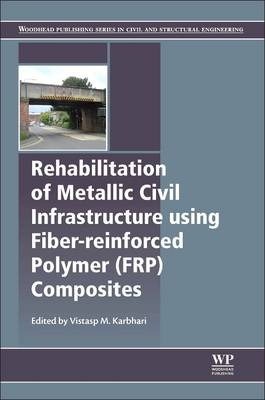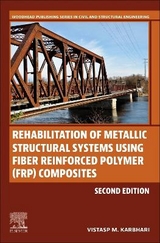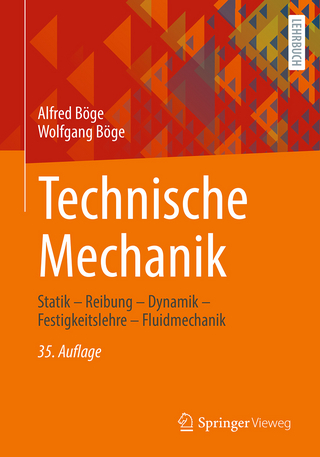
Rehabilitation of Metallic Civil Infrastructure Using Fiber Reinforced Polymer (FRP) Composites
Woodhead Publishing Ltd (Verlag)
9780857096531 (ISBN)
- Titel erscheint in neuer Auflage
- Artikel merken
Fiber-reinforced polymer (FRP) composites are becoming increasingly popular as a material for rehabilitating aging and damaged structures. Rehabilitation of Metallic Civil Infrastructure Using Fiber-Reinforced Polymer (FRP) Composites explores the use of fiber-reinforced composites for enhancing the stability and extending the life of metallic infrastructure such as bridges.
Part I provides an overview of materials and repair, encompassing topics of joining steel to FRP composites, finite element modeling, and durability issues. Part II discusses the use of FRP composites to repair steel components, focusing on thin-walled (hollow) steel sections, steel tension members, and cracked aluminum components. Building on Part II, the third part of the book reviews the fatigue life of strengthened components. Finally, Part IV covers the use of FRP composites to rehabilitate different types of metallic infrastructure, with chapters on bridges, historical metallic structures and other types of metallic infrastructure.
Rehabilitation of Metallic Civil Infrastructure Using Fiber-Reinforced Polymer (FRP) Composites represents a standard reference for engineers and designers in infrastructure and fiber-reinforced polymer areas and manufacturers in the infrastructure industry, as well as academics and researchers in the field.
Dr. Vistasp Karbhari is a Professor in the Departments of Civil Engineering, and Mechanical & Aerospace Engineering at the University of Texas at Arlington where he served as the 8th President. An internationally reputed researcher, Dr. Karbhari is an expert in the processing and mechanics of composites, durability of materials, infrastructure rehabilitation, and multi-threat mitigation and has authored/coauthored over 460 papers in journals and conference publications and is the editor/co-editor of 6 books. He is a fellow of the American Association for the Advancement of Science (AAAS); the National Academy of Inventors (NAI); ASM International; the International Institute for Fiber-reinforced Polymers in Construction; the International Society for Structural Health Monitoring of Intelligent Infrastructure; the American Society of Civil Engineers; and the ASCE’s Structural Engineering Institute, and is a member of the European Academy of Sciences and Arts.
Dedication
Contributor contact details
Woodhead Publishing Series in Civil and Structural Engineering
Preface
Part I: Introduction and overview
Chapter 1: Rehabilitation of metallic civil infrastructure using fiber-reinforced polymer (FRP) composites: a materials and systems overview at the adhesive bond level
Abstract:
1.1 Introduction
1.2 Overall considerations
1.3 Understanding adhesive bonds
1.4 Bond level considerations
1.5 Summary and conclusion
Chapter 2: Repair of metallic airframe components using fibre-reinforced polymer (FRP) composites
Abstract:
2.1 Introduction
2.2 Metallic airframe components
2.3 Key issues in repair
2.4 The use of adhesively bonded patch repairs
2.5 Composite materials and adhesives for bonded patch repairs
2.6 Application technologies and non-destructive inspection of bonded repairs
2.7 Design and modelling of bonded composite repairs
2.8 Certification of repairs to primary structures
2.9 Validation of certified repairs
2.10 Case studies
2.11 Conclusion: limitations and lessons learnt
2.12 Acknowledgement
Chapter 3: Finite element modelling of adhesive bonds joining fibre-reinforced polymer (FRP) composites to steel
Abstract:
3.1 Introduction
3.2 Behaviour of adhesive joints
3.3 Analysis of adhesive joints
3.4 Singular stress fields
3.5 Strain distribution in adhesive joints
3.6 The contribution of the finite element method in the analysis of geometrically modified adhesive joints
3.7 Conclusion
Chapter 4: Durability of steel components strengthened with fiber-reinforced polymer (FRP) composites
Abstract:
4.1 Introduction
4.2 Basic degradation mechanisms
4.3 Galvanic corrosion
4.4 Degradation of the bulk adhesive
4.5 Degradation of the steel/adhesive interface
4.6 Conclusion and future trends
4.7 Sources of further information and advice
Part II: Application to components
Chapter 5: Enhancing the stability of structural steel components using fibre-reinforced polymer (FRP) composites
Abstract:
5.1 Introduction
5.2 Inelastic section (local) buckling
5.3 Buckling (crippling) induced by high local stresses
5.4 Elastic global (Euler) buckling
5.5 Field applications of fibre-reinforced polymer (FRP)-stabilised steel sections
5.6 Conclusion and future trends
Chapter 6: Strengthening of thin-walled (hollow) steel sections using fibre-reinforced polymer (FRP) composites
Abstract:
6.1 Introduction
6.2 Testing thin-walled steel square hollow sections (SHS) and spot-welded (SW) SHS strengthened with carbon fibre-reinforced polymer (CFRP) composites
6.3 Strengthening of thin-walled steel sections for axial compression
6.4 Strengthening of thin-walled steel sections for axial impact
6.5 The role of the steel–CFRP bond
6.6 Conclusion and future trends
Chapter 7: Rehabilitation of steel tension members using fiber-reinforced polymer (FRP) composites
Abstract:
7.1 Introduction
7.2 Repair methods
7.3 Adhesive bonding of fiber-reinforced polymer (FRP) laminates
7.4 Materials
7.5 Bond enhancement
7.6 Fundamentals of analysis and design
7.7 Conclusion and future trends
7.8 Sources of further information and advice
Chapter 8: Rehabilitation of cracked aluminum components using fiber-reinforced polymer (FRP) composites
Abstract:
8.1 Introduction
8.2 Rehabilitation of connections in aluminum overhead sign structures (OSS)
8.3 Static tests of K-tube-to-tube connections
8.4 Constant amplitude fatigue performance of K-tube-to-tube connections
8.5 Conclusion and future trends
8.6 Acknowledgments
Part III: Fatigue performance
Chapter 9: Fatigue life of adhesive bonds joining carbon fibre-reinforced polymer (CFRP) composites to steel components
Abstract:
9.1 Introduction
9.2 Previous research on the fatigue performance of adhesive bonding between carbon fibre-reinforced polymer (CFRP) plates and steel substrates
9.3 Modelling and predicting fatigue of adhesive bonds
9.4 Testing adhesive bonds
9.5 Test results and analysis
9.6 Conclusion and future trends
9.7 Acknowledgements
Chapter 10: Fatigue life of steel components strengthened with fibre-reinforced polymer (FRP) composites
Abstract:
10.1 Introduction
10.2 Improvement of the fatigue life of steel components
10.3 Fracture mechanics modelling
10.4 Fibre-reinforced polymer (FRP) strengthening of steel girders
10.5 Strengthening of welded details
10.6 Design of FRP reinforcement
10.7 Conclusion and future trends
Chapter 11: Extending the fatigue life of steel bridges using fiber-reinforced polymer (FRP) composites
Abstract:
11.1 Introduction
11.2 The development of composite materials for the repair of fatigue damage
11.3 Understanding fatigue damage in steel bridges
11.4 Repair of fatigue cracks in plates subjected to tension
11.5 Repair of welded connections
11.6 Repair of fatigue damage due to out-of-plane forces
11.7 Conclusion
Part IV: Application to infrastructure systems
Chapter 12: Using fibre-reinforced polymer (FRP) composites to rehabilitate differing types of metallic infrastructure
Abstract:
12.1 Introduction
12.2 Types of metallic materials and structures needing rehabilitation
12.3 Structural deficiencies in metallic structures
12.4 Strengthening metallic structures using fibre-reinforced polymer (FRP) composites
12.5 Rehabilitating cast iron bridges and other structures: case studies
12.6 Rehabilitating steel structures: case studies
12.7 Rehabilitating an aluminium beam structure: a case study
12.8 Rehabilitation of onshore and offshore pipe work and other infrastructure
12.9 Conclusion: the use of FRP composites to strengthen metallic structures
12.10 Acknowledgements
Chapter 13: Assessment and rehabilitation of steel railway bridges using fibre-reinforced polymer (FRP) composites
Abstract:
13.1 Introduction
13.2 Assessment procedures for damaged bridges
13.3 Rehabilitation and strengthening of bridges with fibre-reinforced polymer (FRP) composites
13.4 Rehabilitation and strengthening against corrosion
13.5 Strengthening of structural members
13.6 Conclusion
Chapter 14: Strengthening of historic metallic structures using fibre-reinforced polymer (FRP) composites
Abstract:
14.1 Introduction
14.2 Brief history of the use of cast iron and wrought iron
14.3 Production, metallurgy and properties of historic irons
14.4 Structures in cast and wrought iron
14.5 Fibre-reinforced polymer (FRP) composite strengthening of cast and wrought iron structures
14.6 Conclusion
Index
| Reihe/Serie | Woodhead Publishing Series in Civil and Structural Engineering |
|---|---|
| Verlagsort | Cambridge |
| Sprache | englisch |
| Maße | 156 x 234 mm |
| Gewicht | 830 g |
| Themenwelt | Technik ► Bauwesen |
| ISBN-13 | 9780857096531 / 9780857096531 |
| Zustand | Neuware |
| Informationen gemäß Produktsicherheitsverordnung (GPSR) | |
| Haben Sie eine Frage zum Produkt? |
aus dem Bereich



